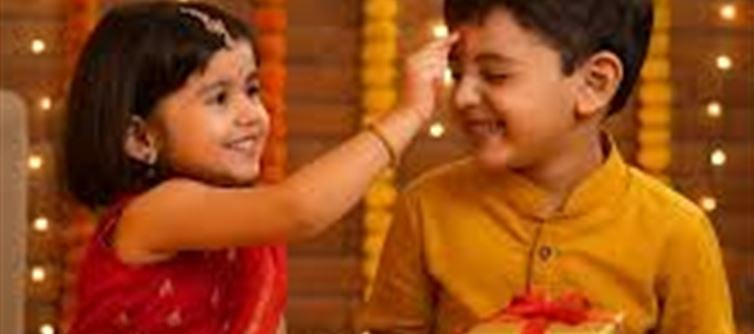
Bhai Dooj, also known as Bhaiya Dooj, Bhai Tika, or Bhau Beej, is one of the most cherished Hindu festivals that celebrates the eternal bond between brothers and sisters. Falling on the second day (Dwitiya Tithi) of the Shukla Paksha in the Kartik month, this auspicious occasion marks the end of the grand diwali festivities. In 2025, Bhai Dooj will be celebrated with traditional fervor and heartfelt rituals across india and among Hindu communities worldwide.
The legend Behind Bhai Dooj
The origin of Bhai Dooj is deeply rooted in ancient Hindu mythology. According to legend, after slaying the demon Narakasura, Lord Krishna visited his sister Subhadra, who welcomed him with a grand feast. She lovingly applied a tilak (vermillion mark) on his forehead and performed aarti to celebrate his victory and to pray for his long life and happiness. Since then, the day has been observed as Bhai Dooj, symbolizing a sister’s prayers and love for her brother’s well-being.
Another tale links the festival to Yamraj, the god of death, and his sister Yamuna. It is believed that yamuna invited her brother to her home and welcomed him with flowers, sweets, and a sacred tilak. Touched by her affection, Yamraj declared that any brother who visits his sister on this day and receives the ceremonial tilak will be blessed with health, wealth, and longevity.
Rituals and Traditions of Bhai Dooj
On the morning of Bhai Dooj, both brothers and sisters take a holy bath, often in sacred rivers, symbolizing purity and renewal. Sisters prepare elaborate puja thalis containing a diya (lamp), roli, rice, sweets, and coconut. The brother sits facing east, and the sister applies a tilak of vermilion, sandalwood, and rice on his forehead while lighting a sacred lamp (diya). The flame of this lamp holds deep spiritual meaning—it is considered a divine witness to the sacred bond and prayers being offered.
After the ritual, sisters perform aarti of their brothers and offer sweets, symbolizing the sweetness of their relationship. In return, brothers give gifts or money to their sisters as a token of love and gratitude, promising to protect them throughout their lives.
Significance of Keeping the Lamp Lit
The lamp (diya) plays a central role in Bhai Dooj celebrations. Its continuous flame is a symbol of divine light, positivity, and protection. Here’s what it represents:
- Symbol of Eternal Love: The steady glow of the diya represents the unwavering affection and lifelong bond between a brother and sister.
- Dispeller of Negativity: Lighting the lamp is believed to drive away evil spirits and negativity, bringing peace and harmony to the home.
- Spiritual Illumination: The flame signifies wisdom, purity, and the victory of light over darkness—mirroring the triumph of good over evil celebrated throughout Diwali.
- A Blessing for Longevity: Keeping the lamp lit during the tilak ceremony is considered auspicious, ensuring the brother’s long life and prosperity.
- Divine Connection: In many traditions, the diya is said to invoke divine blessings from Lord Yama and Goddess Yamuna, reinforcing the festival’s mythological roots.
Regional Variations Across India
Bhai Dooj is celebrated with regional variations across India:
- In Uttar Pradesh and Bihar, it is known as Bhaiya Dooj and includes traditional feasts and gift exchanges.
- In Maharashtra, sisters invite their brothers for a grand meal that includes basundi poori or shrikhand poori.
- In West Bengal, the festival is called Bhai Phonta, where sisters fast until they apply the tilak on their brothers’ foreheads.
- In Nepal, it is celebrated as Bhai Tika, where sisters offer seven-colored tika to their brothers, symbolizing protection and good fortune.
Modern Relevance of Bhai Dooj
In today’s fast-paced world, Bhai Dooj remains a reminder of the value of family bonds and unconditional love. The act of lighting the lamp and performing the rituals connects siblings not only to each other but also to their cultural and spiritual roots. Even if separated by distance, many brothers and sisters celebrate virtually or send symbolic gifts and messages, keeping the essence of the festival alive.
Conclusion
Bhai Dooj 2025 is more than just a festival—it’s a celebration of the sacred bond between siblings, illuminated by the warmth of tradition and the soft glow of a diya. The act of keeping the lamp lit is a timeless reminder that love, light, and blessings transcend darkness, distance, and time.
Disclaimer:
The views and opinions expressed in this article are those of the author and do not necessarily reflect the official policy or position of any agency, organization, employer, or company. All information provided is for general informational purposes only. While every effort has been made to ensure accuracy, we make no representations or warranties of any kind, express or implied, about the completeness, reliability, or suitability of the information contained herein. Readers are advised to verify facts and seek professional advice where necessary. Any reliance placed on such information is strictly at the reader’s own risk.




 click and follow Indiaherald WhatsApp channel
click and follow Indiaherald WhatsApp channel